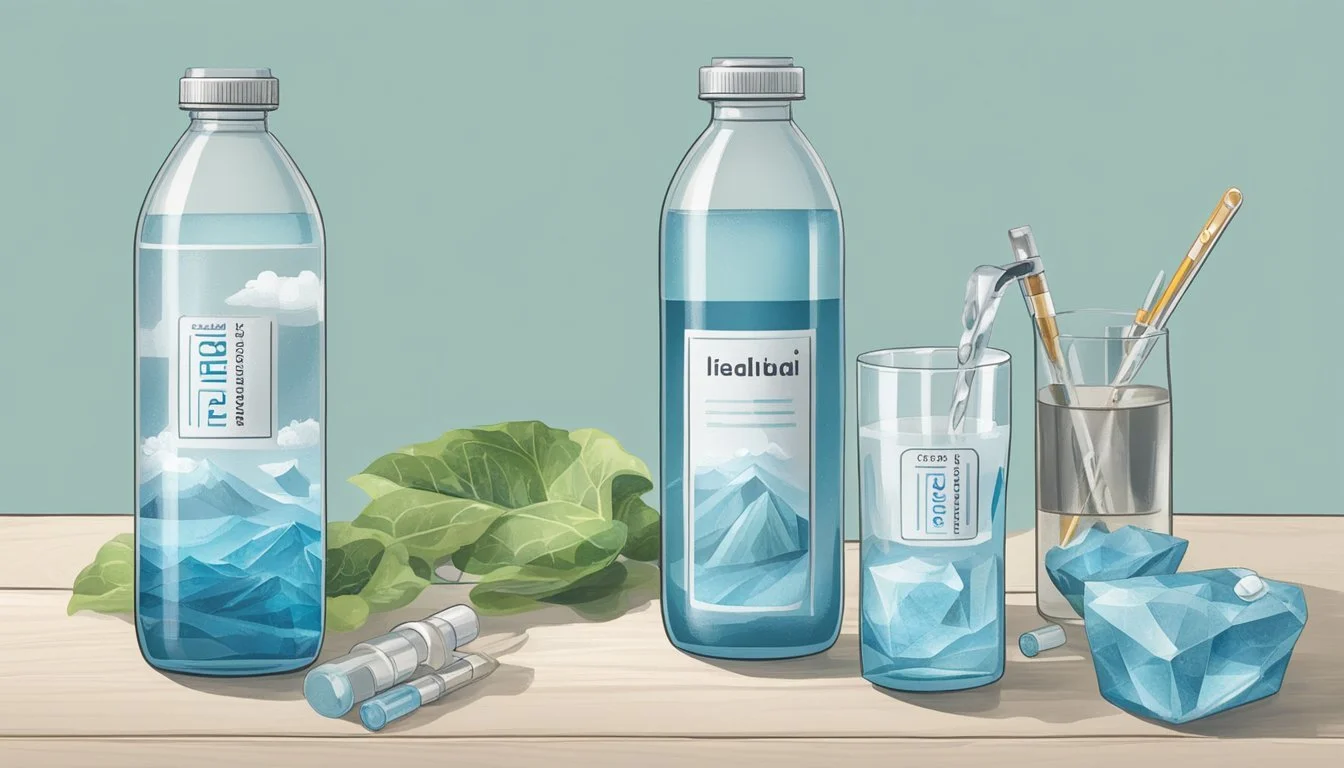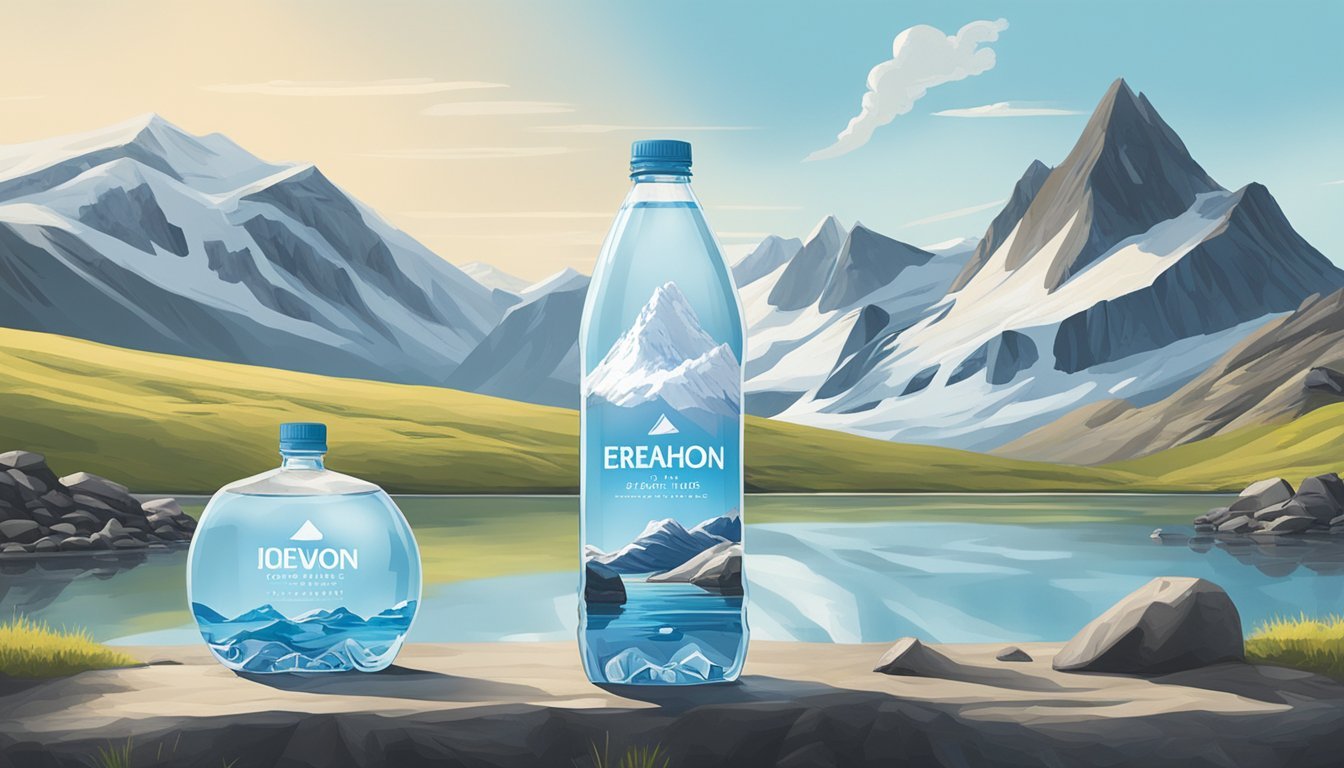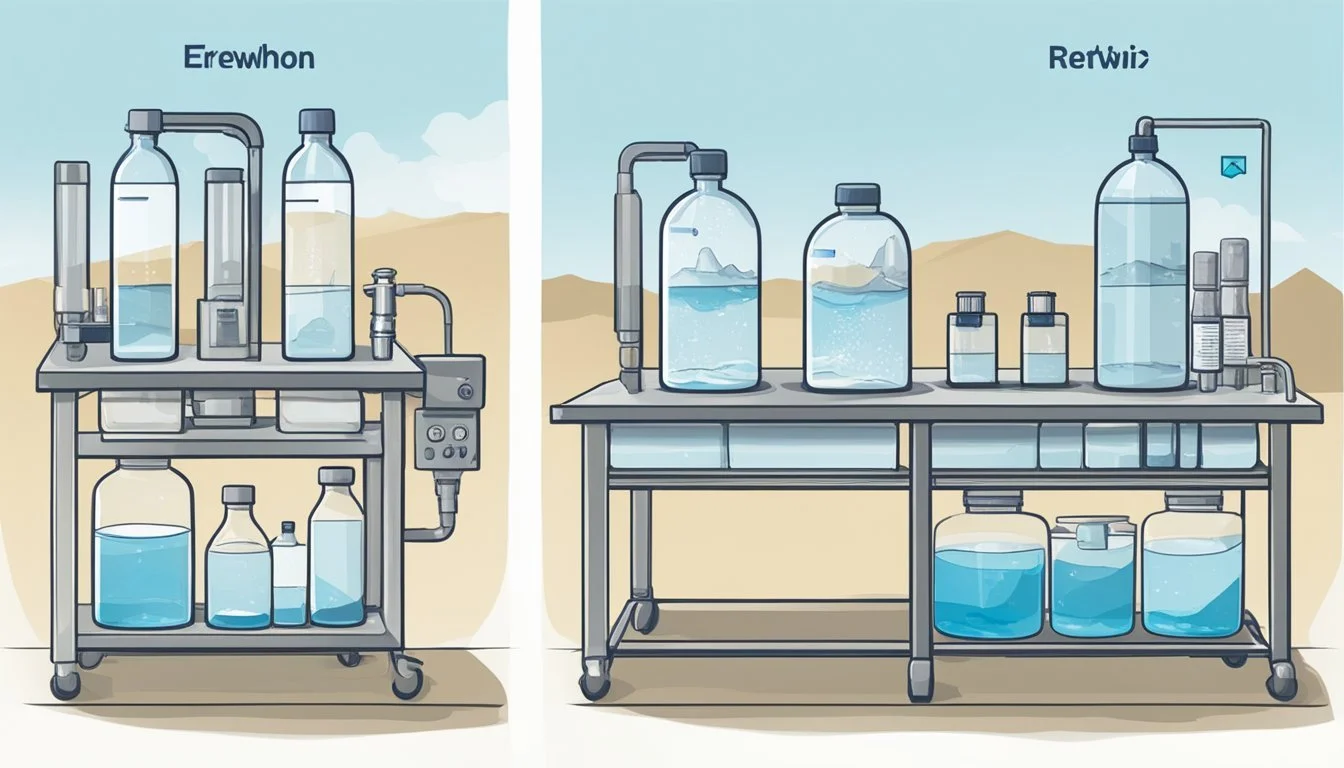Icelandic Glacial vs. Erewhon
Bottled Water Showdown
When it comes to premium bottled water, two brands often stand out: Icelandic Glacial and Erewhon. Each of these waters boasts unique qualities that appeal to consumers looking for purity and exceptional taste. For those who prioritize purity and a clean, crisp taste, Icelandic Glacial might be the best choice.
Icelandic Glacial is known for its pristine source and balanced mineral content, providing a refreshing experience. With its origin in Iceland's legendary Ölfus Spring, this water is both naturally alkaline and sustainably sourced. On the other hand, Erewhon, a brand synonymous with luxury, offers an artisanal experience that speaks to those who wish for an elevated drinking experience through curated mineral content and premium packaging.
Comparing these two could come down to personal preferences. Those who value a straightforward, pure water experience might favor Icelandic Glacial. Meanwhile, those drawn to artisanal, meticulously sourced products might find Erewhon's offerings more aligned with their tastes.
Understanding Bottled Water
This section explores various bottled water brands, the importance of their water sources, and the health benefits and hydration they provide.
A Quick Overview of Bottled Water Brands
Bottled water comes in diverse options, each catering to different preferences and needs. Leading brands like Icelandic Glacial, Smartwater, Dasani, and Aquafina are frequently chosen for their distinct qualities. Icelandic Glacial is known for its purity and origin from the Ölfus Spring in Iceland. Smartwater is popular for its vapor-distilled water with added electrolytes for a clean taste. Affordable brands like Nestlé Pure Life and Poland Spring are often derived from municipal sources but are extensively purified.
Fiji and Voss are renowned for their artesian water sources, offering a smooth taste thanks to their unique mineral compositions. The variety of brands provides consumers with a wide range of options, whether they seek premium, eco-friendly options or budget-friendly choices.
The Significance of Water Sources
The origin of bottled water significantly impacts its quality and composition. Natural spring water, such as that from Icelandic Glacial, is sourced from pristine springs, often filtered naturally through volcanic rock, enhancing its purity and mineral content. Icelandic Glacial, for example, originates from the Ölfus Spring, known for its high pH and exceptional clarity.
Essentia and Core Hydration offer purified water, which is often subject to rigorous filtration processes to remove impurities and add beneficial minerals like electrolytes. Municipal water, utilized by brands like Dasani and Aquafina, undergoes advanced treatments to ensure it meets safety standards.
Mountain spring water from brands like Castle Rock is another sought-after source, known for its crisp taste and natural mineral profile. The water source plays a pivotal role in determining the taste, quality, and health benefits of bottled water.
Health and Hydration
Bottled water provides essential hydration and can contribute to better health due to its mineral content. Icelandic Glacial water, for instance, contains natural minerals like calcium, magnesium, and potassium, which are beneficial for maintaining healthy bodily functions.
Electrolytes added to brands such as Smartwater can help replenish those lost through sweat, making them ideal for athletes. Some bottled waters are also rich in silica, which may promote healthy skin, hair, and nails.
While most bottled waters aim to provide pure, safe drinking water, the variety in mineral content and pH levels can cater to individual health needs. It's crucial to choose a brand that aligns with one's health objectives and personal taste preferences.
Icelandic Glacial and Erewhon: An Introduction
Icelandic Glacial and Erewhon bottled waters each possess unique characteristics that set them apart. They differ in origin, production methods, taste, and purity levels.
Origin and Production
Icelandic Glacial is sourced from the renowned Ölfus Spring in Iceland, one of the world's largest and cleanest natural springs. This spring is replenished by a mixture of rainfall and snowmelt, creating an abundant and sustainable water resource. The water is bottled directly at a high-tech facility right at the spring site, and the brand boasts a naturally alkaline pH of 8.4.
Erewhon water typically comes from various natural sources depending on the specific product line, often favoring natural springs. Unlike Icelandic Glacial, Erewhon sources its water globally and emphasizes organic and sustainable farming practices for its products. Each batch of Erewhon water undergoes rigorous filtration to remove impurities, ensuring high standards of purity.
Taste and Purity
Taste is a significant factor for both Icelandic Glacial and Erewhon waters. Icelandic Glacial, with its naturally high pH, offers a smooth, crisp taste with low total dissolved solids (TDS). The slow filtration through lava rock imparts a unique mineral profile, contributing to its clean and refreshing flavor.
Erewhon water, sourced from various springs, provides a diverse palate experience. The taste can vary but often highlights a balanced mineral content, ensuring a fresh and slightly sweet profile. Erewhon’s focus on rigorous purification methods ensures that each bottle delivers consistently pure and clean water, catering to those who value high-quality hydration options.
Both brands maintain a commitment to purity, with Icelandic Glacial boasting an impressively low TDS and Erewhon emphasizing thorough filtration processes. Each offers a distinct drinking experience reflective of their unique sourcing and production standards.
Comparing pH Levels and Health Impact
The comparison between Icelandic Glacial and Erewhon bottled water hinges on their pH levels and potential health effects. These aspects are crucial as they influence water's taste, its interaction with the body, and possible health benefits or concerns.
Understanding pH in Drinking Water
pH level indicates how acidic or alkaline a substance is. The pH scale ranges from 0 to 14, with 7 being neutral. In bottled water, a pH level between 6.5 and 8.5 is often considered optimal for taste and health.
Icelandic Glacial water typically has an alkaline pH level above 7, often noted for its purity and natural filtration process. In contrast, Erewhon, although offering high-quality water, may vary in its pH levels depending on the source and specific bottling practices.
Alkaline water is often marketed for its potential health benefits, such as neutralizing acid in the bloodstream and improving hydration. Understanding the pH levels can help consumers make informed choices based on their personal health and hydration needs.
Health Implications of pH
The pH level of water can have noticeable effects on health. Alkaline water, like Icelandic Glacial, with its higher pH, is claimed by some to help balance the body’s pH levels and improve hydration. However, scientific consensus on these benefits is mixed, and more research is needed.
Erewhon's water, which may have a more neutral or slightly alkaline pH depending on the source, also supports basic hydration needs effectively. Proper hydration is essential for bodily functions and can potentially influence energy levels, digestion, and overall well-being.
Consumers should consider their own health conditions when choosing between Icelandic Glacial and Erewhon. Those with specific medical conditions or dietary requirements may benefit more from one type of water over the other based on pH levels.
Packaging and Environmental Responsibility
Icelandic Glacial and Erewhon bottled waters each emphasize their commitment to sustainable packaging and minimizing environmental impact. These efforts include using eco-friendly materials and reducing their carbon footprints.
Sustainability Commitments
Icelandic Glacial places significant emphasis on being carbon neutral, achieving certification for their carbon-neutral operations. They invest in renewable energy projects and offset emissions through verified carbon credits. Their recyclable PET bottles are notable, but they also encourage recycling and responsible consumption among their consumers.
Erewhon similarly highlights sustainability in their mission. They use BPA-free, recyclable materials for their bottles and prioritize sourcing that minimizes environmental impact. Their packaging often involves glass bottles, preferred for being more environmentally friendly and reducing the carbon footprint compared to traditional plastic bottles.
Analyzing Bottles and Their Impact
Icelandic Glacial utilizes PET bottles, which are lightweight and recyclable. The environmental impact of PET bottles is mitigated by their recycling initiatives and carbon-neutral operations. Additionally, their bottles are designed to be eco-friendly, with a focus on minimizing waste.
Erewhon uses glass bottles, which are 100% recyclable and free from harmful chemicals like BPA. Glass bottles tend to have a longer life cycle if reused, presenting a lower carbon footprint in the long run. Consumers often prefer glass for its perceived purity and sustainability advantages over plastic.
Both brands show strong commitments to sustainability, but their approaches differ.
Consumer Convenience and Accessibility
Accessibility and convenience are critical factors when choosing between Icelandic Glacial and Erewhon bottled water. Consumers often weigh the availability of the product in retail locations and the ease with which they can transport and use these products in their daily lives.
Availability in Retail Locations
Icelandic Glacial water is widely available in many major grocery stores, convenience stores, and online retailers. Its extensive distribution network ensures that consumers can easily find it in many parts of the world.
Erewhon, on the other hand, is a premium brand with a more limited distribution. It's often found in specialty health stores and upscale markets, making it less accessible for some consumers. This could restrict its availability to specific regions or urban centers where such stores are prevalent.
Retail availability directly affects the convenience of purchasing bottled water. Icelandic Glacial’s broad market presence gives it a significant edge in terms of accessibility compared to Erewhon's more niche market placement.
Ease of Use and Transportation
Both bottled water brands offer packaging designed for user convenience, reflecting their commitment to consumer needs. Icelandic Glacial bottles are typically lightweight and designed for portability, making them easy to carry in bags, backpacks, or by hand. Their bottles come in various sizes, catering to different consumption needs, whether it's for travel or daily hydration.
Erewhon also places a strong emphasis on packaging aesthetics and functionality. It often uses recyclable materials and minimalist design, appealing to environmentally-conscious consumers. The bottles are sturdy, designed to withstand transportation without damaging the product inside. However, Erewhon’s focus on premium packaging might sometimes result in slightly heavier bottles, which could be a consideration for those who prioritize lightness and ease of carrying.
Both brands ensure their bottles are user-friendly, but Icelandic Glacial’s variety in bottle sizes and widespread availability in stores arguably makes it more customer-friendly for everyday use compared to Erewhon.
Assessing Purity and Contamination Levels
Both Icelandic Glacial and Erewhon emphasize purity in their marketing. This section examines their filtration methods, levels of purity, and potential contaminants.
Evaluating Filtration and Purity Protocols
Icelandic Glacial sources its water from the Ölfus Spring in Iceland. Known for its natural filtration through volcanic rock, this process ensures minimal contamination. The brand boasts low total dissolved solids (TDS) and high oxygen content, aligning with stringent FDA and EPA regulations.
Erewhon water relies on an advanced Hydro-7 filtration process. This method claims to remove microplastic particles and other pollutants efficiently. The purity protocols of Erewhon also include comprehensive quality reports, ensuring transparency and adherence to health standards.
Impact of Contaminants
Examining contaminants, Icelandic Glacial shows significantly low levels of nitrates and minimal traces of pollutants. Their bottling directly at the source further reduces the risk of contamination.
Erewhon water is advertised as exceptionally free from additives, pollutants, and microplastic particles due to its Hydro-7 process. Regular testing confirms low contaminant levels, meeting and often exceeding EPA and FDA standards for bottled water quality.
Both brands prioritize minimizing environmental waste and recycling. This commitment further assures consumers of their attention to maintaining water quality and purity.
Final Verdict on Icelandic Glacial vs. Erewhon
Icelandic Glacial and Erewhon offer distinct benefits to consumers, particularly in terms of purity, taste, packaging, and environmental impact. A close examination of each brand will aid consumers in making an informed decision.
Comparative Summary of Both Brands
Icelandic Glacial
Purity: Sourced from the Ölfus Spring in Iceland, it boasts a high pH of 8.4, making it naturally alkaline.
Taste: Filtered through lava rock, it delivers a crisp, clean taste.
Health: Its natural alkalinity may be beneficial for those seeking balanced pH levels.
Packaging: Notable for being CarbonNeutral Certified, reflecting their commitment to sustainability.
Environmental Impact: Uses eco-friendly practices in bottling and packaging, lowering the carbon footprint.
Erewhon
Purity: Features water sourced from artesian wells, ensuring minimal contamination.
Taste: Recognized for its neutral and refreshing taste, catering to a wide audience.
Health: Often includes minerals that are beneficial for health.
Packaging: Attractive and functional, yet fewer details on eco-certifications compared to Icelandic Glacial.
Environmental Impact: Limited information on sustainability practices, which might concern environmentally-conscious consumers.
Recommendations for Consumers
Consumers should consider their priorities when choosing between Icelandic Glacial and Erewhon.
For Purity and Health: Opt for Icelandic Glacial if seeking water with a naturally high pH and minimal contaminants.
For Taste Preference: Both offer excellent taste, but Icelandic Glacial's unique filtration process may offer a slight edge.
For Environmental Impact: Icelandic Glacial's eco-friendly certifications and practices make it a preferable choice for environmentally-conscious buyers.
Taking these factors into account, individuals can select the bottled water brand that best meets their needs and values. Both brands stand out in multiple areas, making either a strong choice depending on consumer priorities.
Appendix: Water Brand Profiles
This section provides detailed profiles of Erewhon and a selection of additional market players, highlighting key characteristics that position each brand in the competitive bottled water market.
Erewhon: Brand Overview
Erewhon is known for its dedication to sourcing some of the finest natural foods and beverages. The brand emphasizes organic and sustainably sourced products, which extend to its bottled water offerings.
Sourcing: Erewhon waters are typically sourced from protected springs and other natural sources, ensuring minimal environmental impact.
Purity: High purity standards are maintained, with rigorous testing for contaminants. This guarantees clean and fresh water, often with a balanced mineral content.
Packaging: Erewhon prioritizes sustainable packaging solutions, frequently utilizing recyclable and BPA-free materials to reduce plastic waste.
Additional Market Players
Several other brands compete in the bottled water market, each with unique features:
Source: French Alps
Characteristics: Naturally filtered through glacial sand, rich in minerals
Packaging: Eco-friendly initiatives, recyclable materials
Acqua Panna:
Source: Tuscany, Italy
Characteristics: Smooth taste, balanced pH
Packaging: 100% recyclable
San Pellegrino:
Source: San Pellegrino Terme, Italy
Characteristics: Sparkling water, high natural carbonation
Packaging: Recyclable glass, plastic options
Glaceau Smartwater:
Source: Vapor-distilled water, various US locations
Characteristics: Added electrolytes for taste
Packaging: Often uses recycled materials
Source: Various locations
Characteristics: Supports clean water initiatives globally
Packaging: Recyclable plastic materials
Other notable brands like Penta, Zephyrhills, Flow, and LIFEWTR each bring unique solutions to the table, focusing on factors such as purity, source sustainability, and innovative packaging. These brands contribute to a diverse and dynamic bottled water market, offering consumers a range of choices to meet their specific needs and preferences.
More About Icelandic Glacial
Acqua Panna vs Icelandic Glacial: Which Bottled Water is Better?
Aquafina vs Icelandic Glacial: Which Bottled Water is Better?
Arrowhead vs Icelandic Glacial: Which Bottled Water is Better?
Boxed Water vs Icelandic Glacial: Which Bottled Water is Better?
Core Hydration vs Icelandic Glacial: Which Bottled Water is Better?
Deer Park vs Icelandic Glacial: Which Bottled Water is Better?
Essentia vs Icelandic Glacial: Which Bottled Water is Better?
Eternal vs Icelandic Glacial: Which Bottled Water is Better?
Ice Mountain vs Icelandic Glacial: Which Bottled Water is Better?
Icelandic Glacial vs 1907water: Which Bottled Water is Better?
Icelandic Glacial vs 7-Select: Which Bottled Water is Better?
Icelandic Glacial vs Alkaline88: Which Bottled Water is Better?
Icelandic Glacial vs Antipodes: Which Bottled Water is Better?
Icelandic Glacial vs Aqua Carpatica: Which Bottled Water is Better?
Icelandic Glacial vs Big Chill: Which Bottled Water is Better?
Icelandic Glacial vs Big Win: Which Bottled Water is Better?
Icelandic Glacial vs BodyArmor: Which Bottled Water is Better?
Icelandic Glacial vs Cascade Mountain: Which Bottled Water is Better?
Icelandic Glacial vs Castle Rock: Which Bottled Water is Better?
Icelandic Glacial vs CBD Living: Which Bottled Water is Better?
Icelandic Glacial vs Crystal Geyser: Which Bottled Water is Better?
Icelandic Glacial vs Crystal Lake: Which Bottled Water is Better?
Icelandic Glacial vs Essence pH10: Which Bottled Water is Better?
Icelandic Glacial vs Hawaii Volcanic: Which Bottled Water is Better?
Icelandic Glacial vs Hawaiian Springs: Which Bottled Water is Better?
Icelandic Glacial vs Just Water: Which Bottled Water is Better?
Icelandic Glacial vs Kirkland Signature: Which Bottled Water is Better?
Icelandic Glacial vs LIFEWTR: Which Bottled Water is Better?
Icelandic Glacial vs Liquid Death: Which Bottled Water is Better?
Icelandic Glacial vs Mananalu: Which Bottled Water is Better?
Icelandic Glacial vs Mountain Valley Spring Water: Which Bottled Water is Better?
Icelandic Glacial vs Nestle Pure Life: Which Bottled Water is Better?
Icelandic Glacial vs Open Water: Which Bottled Water is Better?
Icelandic Glacial vs Perrier: Which Bottled Water is Better?
Icelandic Glacial vs Poland Spring: Which Bottled Water is Better?
Icelandic Glacial vs Proud Source: Which Bottled Water is Better?
Icelandic Glacial vs Pure Life: Which Bottled Water is Better?
Icelandic Glacial vs Purely Sedona: Which Bottled Water is Better?
Icelandic Glacial vs Refreshe: Which Bottled Water is Better?
Icelandic Glacial vs Richard's Rainwater: Which Bottled Water is Better?
Icelandic Glacial vs San Pellegrino: Which Bottled Water is Better?
Icelandic Glacial vs Simple Truth: Which Bottled Water is Better?
Icelandic Glacial vs Smartwater: Which Bottled Water is Better?
Icelandic Glacial vs Solan de Cabras: Which Bottled Water is Better?
Icelandic Glacial vs Starkey: Which Bottled Water is Better?
Icelandic Glacial vs Talking Rain AQA: Which Bottled Water is Better?
Icelandic Glacial vs The Well: Which Bottled Water is Better?
Icelandic Glacial vs Topo Chico: Which Bottled Water is Better?
Icelandic Glacial vs Tru Alka: Which Bottled Water is Better?
Icelandic Glacial vs Waiakea: Which Bottled Water is Better?
Icelandic Glacial vs Weird Water: Which Bottled Water is Better?
Icelandic Glacial vs Whole Foods 365: Which Bottled Water is Better?
Icelandic Glacial vs Whole Foods Italian Still Mineral water: Which Bottled Water is Better?
Icelandic Glacial vs Zephyrhills: Which Bottled Water is Better?
Icelandic Glacial vs HFactor: Which Bottled Water is Better?







